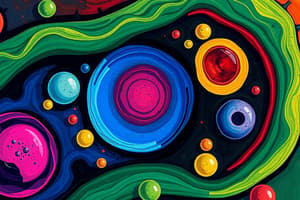Podcast
Questions and Answers
What distinguishes prokaryotic cells from eukaryotic cells?
What distinguishes prokaryotic cells from eukaryotic cells?
Prokaryotic cells lack a nucleus and membrane-bound organelles while eukaryotic cells have a nucleus and organelles.
Describe the function of the mitochondria in a cell.
Describe the function of the mitochondria in a cell.
Mitochondria are known as the powerhouse of the cell, producing ATP through cellular respiration.
What role do lysosomes play in cell function?
What role do lysosomes play in cell function?
Lysosomes contain digestive enzymes that break down waste materials and cellular debris.
Explain the difference between mitosis and meiosis.
Explain the difference between mitosis and meiosis.
What is passive transport and how does it differ from active transport?
What is passive transport and how does it differ from active transport?
What is the function of the Golgi apparatus?
What is the function of the Golgi apparatus?
How do cells communicate with each other?
How do cells communicate with each other?
What is the significance of checkpoints in the cell cycle?
What is the significance of checkpoints in the cell cycle?
Flashcards are hidden until you start studying
Study Notes
Cell Biology
-
Basic Unit of Life
- All living organisms are made up of cells.
- Cells can be prokaryotic (no nucleus, e.g., bacteria) or eukaryotic (with a nucleus, e.g., animal and plant cells).
-
Cell Structure
- Cell Membrane
- Semi-permeable barrier that controls the passage of substances.
- Composed of a phospholipid bilayer with embedded proteins.
- Nucleus
- Contains genetic material (DNA).
- Surrounded by the nuclear envelope.
- Cytoplasm
- Gel-like substance that fills the cell.
- Site for many metabolic reactions.
- Organelles
- Mitochondria: Powerhouse of the cell; produces ATP through cellular respiration.
- Ribosomes: Sites of protein synthesis.
- Endoplasmic Reticulum (ER):
- Rough ER (with ribosomes) synthesizes proteins.
- Smooth ER (without ribosomes) synthesizes lipids and detoxifies.
- Golgi Apparatus: Modifies, sorts, and packages proteins and lipids for secretion or use in the cell.
- Lysosomes: Contains digestive enzymes to break down waste.
- Chloroplasts (only in plant cells): Site of photosynthesis; contains chlorophyll.
- Cell Membrane
-
Cell Division
- Mitosis
- Process of somatic (body) cell division.
- Results in two genetically identical daughter cells.
- Phases: Prophase, Metaphase, Anaphase, Telophase.
- Meiosis
- Process of gamete (sex cell) formation.
- Results in four genetically unique daughter cells.
- Involves two rounds of division (Meiosis I and II).
- Mitosis
-
Cell Transport Mechanisms
- Passive Transport
- Movement of substances across cell membrane without energy.
- Types: Diffusion, Facilitated diffusion, Osmosis.
- Active Transport
- Movement of substances against their concentration gradient; requires energy (ATP).
- Example: Sodium-potassium pump.
- Passive Transport
-
Cell Communication
- Cells communicate through signaling molecules (e.g., hormones, neurotransmitters).
- Receptors on cell membranes receive signals and initiate responses.
-
Cellular Metabolism
- Catabolism: Breakdown of molecules to obtain energy (e.g., glycolysis).
- Anabolism: Synthesis of complex molecules from simpler ones (e.g., protein synthesis).
-
Cell Cycle Regulation
- Cyclins and cyclin-dependent kinases (CDKs) regulate the cell cycle.
- Checkpoints ensure proper division and prevent uncontrolled growth (cancer).
-
Specialized Cells
- Cells can differentiate to perform specific functions (e.g., muscle cells, nerve cells).
- Stem cells can differentiate into various cell types.
Basic Unit of Life
- Living organisms consist of cells, categorized into prokaryotic (no nucleus, e.g., bacteria) and eukaryotic (with nucleus, e.g., animals, plants).
Cell Structure
- Cell Membrane:
- Functions as a semi-permeable barrier regulating substance passage; made of a phospholipid bilayer with proteins embedded.
- Nucleus:
- Houses genetic material (DNA) and is encased by the nuclear envelope.
- Cytoplasm:
- Gel-like matrix filling the cell, serving as the site for metabolic processes.
- Organelles:
- Mitochondria: Known as the "powerhouse"; generates ATP via cellular respiration.
- Ribosomes: Function as the sites for protein synthesis.
- Endoplasmic Reticulum (ER):
- Rough ER with ribosomes synthesizes proteins; Smooth ER without ribosomes synthesizes lipids and detoxifies molecules.
- Golgi Apparatus: Responsible for modifying, sorting, and packaging proteins and lipids for secretion or intracellular use.
- Lysosomes: Contain digestive enzymes to degrade waste materials.
- Chloroplasts (plant cells only): Site of photosynthesis containing chlorophyll.
Cell Division
- Mitosis:
- Somatic cell division resulting in two genetically identical daughter cells; proceeds through phases: Prophase, Metaphase, Anaphase, Telophase.
- Meiosis:
- Gamete formation producing four genetically unique daughter cells through two division rounds (Meiosis I and II).
Cell Transport Mechanisms
- Passive Transport:
- Movement of substances across the membrane without energy; includes diffusion, facilitated diffusion, and osmosis.
- Active Transport:
- Energy-requiring movement against concentration gradients (e.g., sodium-potassium pump).
Cell Communication
- Cells utilize signaling molecules (e.g., hormones, neurotransmitters) for communication; receptors on cell membranes detect signals and trigger responses.
Cellular Metabolism
- Catabolism:
- Processes that break down molecules to release energy (e.g., glycolysis).
- Anabolism:
- Reactions that build complex molecules from simpler units (e.g., protein synthesis).
Cell Cycle Regulation
- Regulated by cyclins and cyclin-dependent kinases (CDKs); checkpoints are included to ensure proper cell division and reduce cancer risk.
Specialized Cells
- Cells can undergo differentiation to adopt specific functions, such as muscle and nerve cells; stem cells have the potential to transform into various cell types.
Studying That Suits You
Use AI to generate personalized quizzes and flashcards to suit your learning preferences.




